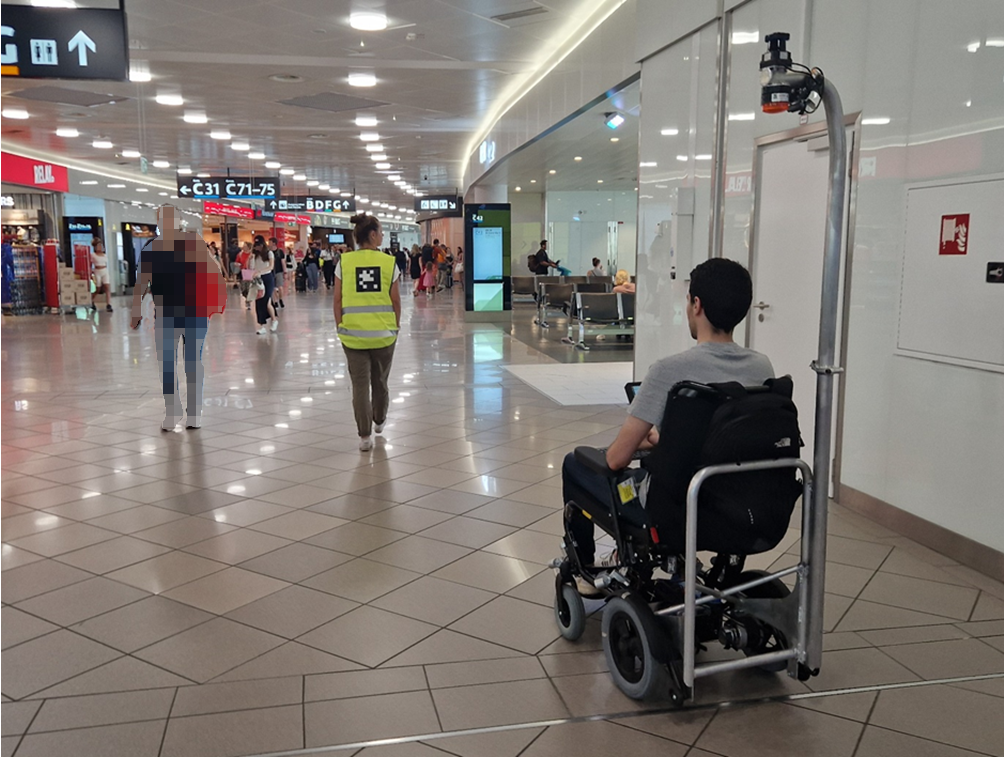AIT has developed an innovative solution for passengers with reduced mobility.
An increasing number of people are travelling by plane, whether for private holidays or business trips. Passenger numbers are rising sharply at many airports, particularly at the start of the travel season. Along with this increase in traffic comes a growing demand for support services, particularly for passengers with reduced mobility (PRM). This growing demand is presenting airports around the world with increasing challenges.
Autonomous wheelchair follows a tag on the back of a PRM assistant
Scalable and efficient wheelchair solution
Reserchers at the AIT Austrian Institute of Technology (AIT) has now teamed up with KLAXON MOBILITY GmbH to develop a forward-looking response to this challenge: an autonomous, electrically powered wheelchair that automatically follows a caregiver.
A clearly visible visual marker attached to the back enables the PRM assistants to be easily and unambiguously identified. This allows a single caregiver to guide and accompany several wheelchairs at the same time. Thanks to this flexible electric wheelchair assistance system, the airport infrastructure remains completely untouched, and no additional mapping is required. ‘Our goal was to create a cost-efficient, modular and therefore scalable solution that can be easily integrated into existing PRM services and operated intuitively,’ explains Monika Riedl-Riedenstein, project manager and expert for assistance and autonomous systems at the Center for Vision, Automation & Control at AIT.
Greater independence for people with limited mobility
Equipped with sophisticated sensor technology, the wheelchair can navigate autonomously and safely through the airport. It dynamically adapts its driving behaviour, recognising obstacles and reacting to passers-by and the environment. It brakes automatically and accelerates or swerves if necessary.
For additional safety, tag recognition is linked to an acoustic alarm system: if the PRM attendant leaves the defined communication radius between the tag and the wheelchair, a warning signal is automatically triggered.
The system has been successfully tested at Vienna Airport, impressing passengers and staff alike with its smooth and safe operation. The scientific community was also impressed by the AIT development. Aleksa Kostic, a developer and programmer who worked on the project, presented the technology to an international audience of experts at the 11th International Conference on Mechatronics and Robotics Engineering (ICMRE). This outstanding achievement was deservedly recognised.
This project represents a significant step towards barrier-free, everyday mobility, providing a solution ready for international rollout.
AIT Center for Vision, Automation & Control: ait.ac.at/vac
KLAXON MOBILITY GmbH: www.klaxon-klick.com/de/
Flughafen Wien AG: www.viennaairport.com
Press release (German)
presse.ait.ac.at/news-autonomer-rollstuhl-fuer-flughaefen-ait-entwickelt-innovative-loesung-fuer-passagiere-mit-eingeschraenkter-mobilitaet
Scientific paper
ieeexplore.ieee.org/document/10976304
A. Kostić, M. Schörghuber, M. Hofstätter and M. Wallner, "Autonomous Following Wheelchair for Passengers with Reduced Mobility at Airports," 2025 11th International Conference on Mechatronics and Robotics Engineering (ICMRE), Lille, France, 2025, pp. 82-89, doi: 10.1109/ICMRE64970.2025.10976304.
Aleksa Kostic from the AIT Center for Vision, Automation & Control receives the Best Demo Award at the 11th International Conference on Mechatronics and Robotics.



